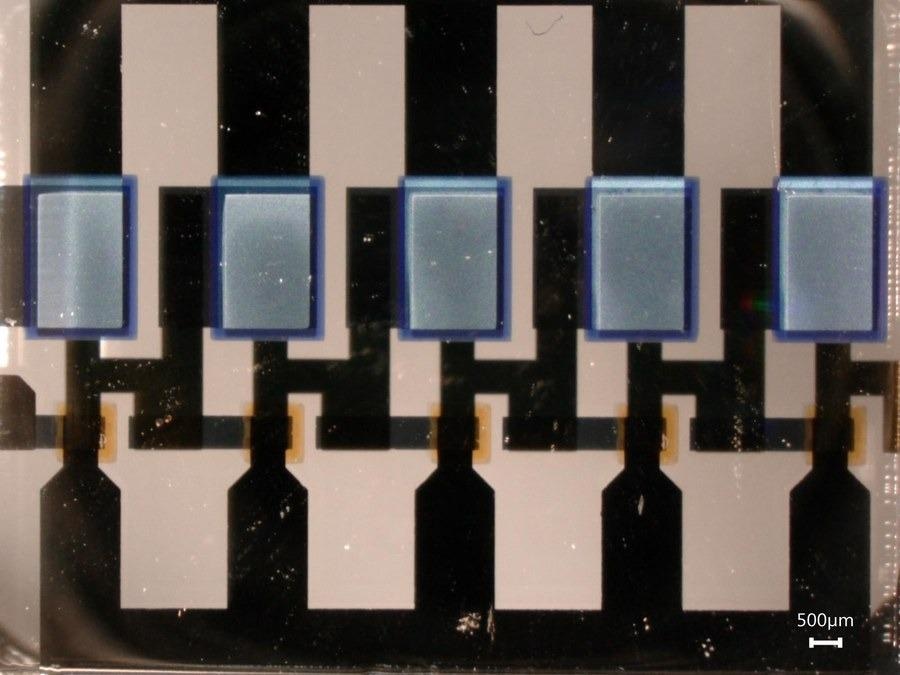At the Technische Universität Dresden (TU Dresden), physicists have established the first implementation of a complementary vertical organic transistor technology, which can operate at low voltage, with adjustable inverter properties and a fall and rise time of below 10 ns shown in inverter and ring-oscillator circuits, respectively.
 Image of a 5-stage complementary ring-oscillator composed of organic permeable base transistors. Image Credit: Technische Universität Dresden.
Image of a 5-stage complementary ring-oscillator composed of organic permeable base transistors. Image Credit: Technische Universität Dresden.
Thanks to the new technology, the researchers are very close to the commercialization of flexible, efficient and printable electronics of the future. Their innovative study results have been published in the renowned journal Nature Electronics.
The commercialization of flexible and printable electronics has been hampered up until now by poor performance. Therefore, the advent of low-voltage, high-frequency and high-gain complementary circuits is observed as one of the most essential targets of research.
High-frequency logic circuits, like oscillators and inverter circuits that exhibit low power consumption and fast response time, are considered to be the vital building blocks for low-power-consumption, large-area, printable and flexible electronics of the future.
At the Institute of Applied Physics (IAP) of TU Dresden, the “Organic Devices and Systems” (ODS) research group, led by Dr. Hans Kleemann, has been striving to develop innovative devices and organic materials for flexible, high-performance and probably even biocompatible electronics and optoelectronics.
In this study, increasing the performance of organic circuits was one of the main challenges. Erjuan Guo, a PhD student, reported a significant discovery with the development of printable, efficient and adjustable vertical organic transistors a few months earlier.
Building on their earlier findings, the physicists have combined vertical organic transistors (organic permeable base transistors, or OPBTs) into functional circuits. Dr. Hans Kleemann and his colleagues have successfully shown that such devices exhibit long-term stability, reliable performance, as well as unmatched performance.
In previous publications, we found that the second control-electrode in the vertical transistor architecture enables a wide-range of threshold voltage controllability, which makes such devices become ideal for efficient, fast and complex logic circuits.
Erjuan Guo, Institute of Applied Physics and Dresden Integrated Center for Applied Physics and Photonic Materials, Technische Universität Dresden
“In the recent publication, we add a vital feature to the technology by demonstrating complementary circuits such as integrated complementary inverters and ring-oscillators. Using such complementary circuits, the power- efficiency and speed of operation can be improved by more than one order of magnitude and might possibly allow organic electronics to enter the GHz-regime,” added Guo, who received a PhD with distinction from Technische Universität Dresden.
The ring-oscillators and complementary inverters created at the IAP are a milestone toward flexible, low-power gigahertz electronics as it would be required, for instance, in wireless communication applications.
Furthermore, our findings might inspire the entire research community to envision alternative vertical organic transistor designs as they seem to enable high-frequency operation and low-cost integrated at the same time.
Erjuan Guo, Institute of Applied Physics and Dresden Integrated Center for Applied Physics and Photonic Materials, Technische Universität Dresden
Journal Reference:
Guo, E., et al. (2021) Integrated complementary inverters and ring oscillators based on vertical-channel dual-base organic thin-film transistors. Nature Electronics. doi.org/10.1038/s41928-021-00613-w.